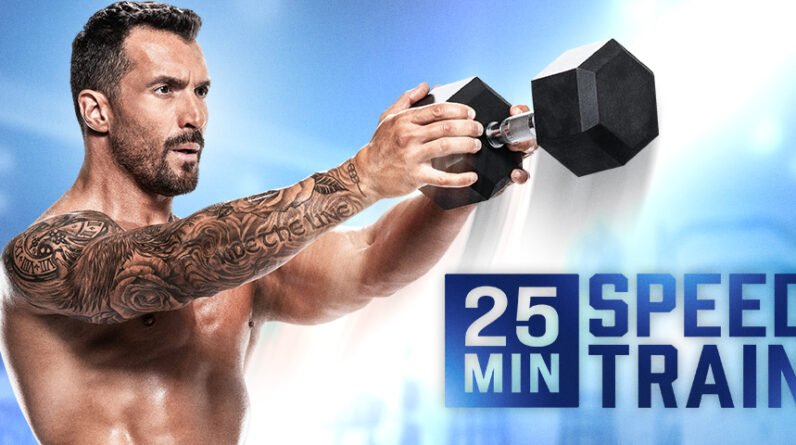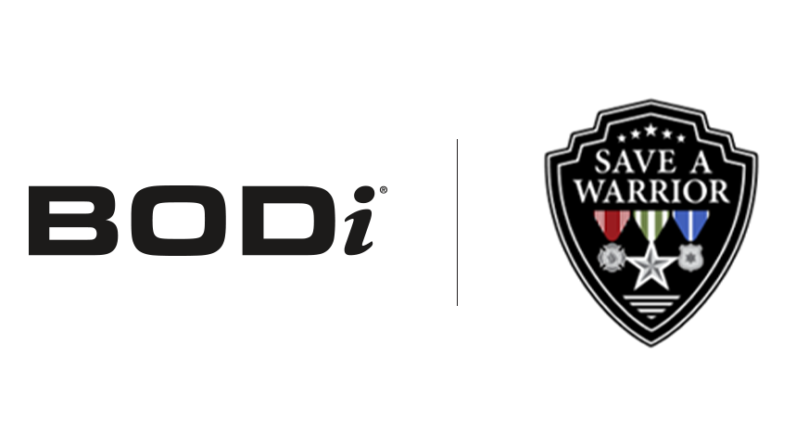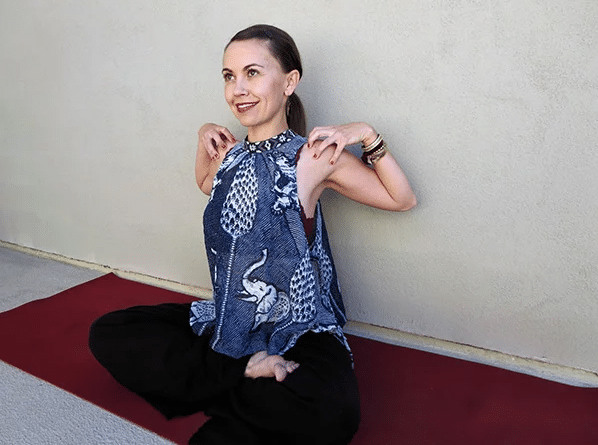
Maybe you want to break out of your split-routine. Or maybe your current workout regimen isn’t effectively hitting all of your major muscle groups. Either way, you could benefit from a full-body workout plan.
Rather than focus on specific types of movement or parts of the body the way you would with a workout split, a total body workout is designed to engage muscles from head to toe. And for those whose usual routine is simpler — think running, cycling, etc. — a full-body workout may target otherwise-neglected muscles and energy systems.
Whether it’s HIIT or heavy lifting, many BODi programs and workouts are comprised of exercises for total body engagement. Follow the full-body workout below made up of moves from several of these programs and discover the benefits of total body training.
Why Do a Full-Body Workout?
A full-body workout forgoes the compartmental focus of a split routine in favor of exercises that work all major muscle groups in a single workout. In addition to the benefits of increased muscle mass, strength, and/or cardiovascular capacity you might get from any workout, full-body workouts offer a number of advantages.
1. Train functional fitness
Using exercises that challenge multiple joints and muscle groups, full-body workouts emphasize functional training, promoting movement patterns that better translate to everyday life. The result is often improved coordination, proprioception, balance, and stability that make daily tasks easier to manage and can reduce the risk of injury in routine activities.
2. Save time
Working your whole body at once allows you to complete your workout quicker, rather than focusing on one or two muscle groups, hammering them for a set, and having to recover before doing it again. It may even allow you to exercise fewer days per week, as you pack more overall work into each session.
3. Burn more calories
The more muscles you use, the more energy you’ll need to power them, and full-body workouts engage more muscle overall — burning more calories in the process. At high intensity, they can also help stimulate increased fat loss.
That’s because working multiple muscle groups simultaneously at high intensity demands additional caloric burn even after you’ve finished your workout thanks to the afterburn effect (also known as excess post-exercise oxygen consumption, or EPOC). This higher calorie burn can contribute substantially to weight loss and improved metabolic health.
4. Improve mobility
Instead of simply curling a dumbbell at your elbows or shuffling your legs at jogging stride, full-body workouts take your limbs (and muscles) through complete ranges of motion.
This helps improve mobility, or your ability to move your joints to their fullest extent. By consistently working on mobility through a full-body workout routine, you also support joint health.
5. Emphasize strength and cardio
There’s not much cardiovascular benefit to an overhead press alone, but when you pair it with a squat, you can significantly increase your heart rate, amplifying your aerobic gains while building strength in both your upper and lower body.
6. Promote muscular balance
Rather than keying solely on mirror muscles, full-body workouts require a more equitable division of labor across the various muscle groups, helping to iron out or prevent muscle imbalances.
Additionally, integrating a full-body workout into your routine can prevent overtraining of specific muscles, reducing the risk of injuries and allowing for more complete muscle recovery.
What to Look for in a Full-Body Workout
The way you structure a workout matters. When auditioning a full-body workout, there are several key qualities to consider:
Fitness-level appropriate
Foremost, it’s important to choose a workout that aligns with your level of fitness in order to maintain proper form, thereby minimizing the risk of injury and maximizing effectiveness. Movements should be challenging without inducing breakdowns in execution.
Compound movements
Any full-body workout should take you through a variety of compound movements, whether they’re bodyweight or loaded exercises. Compound movements engage multiple joints and muscles simultaneously, or at the very least collectively, ensuring holistic muscle activation.
Resistance + aerobics
A well-rounded full-body workout typically incorporates a blend of strength and cardiovascular elements to promote muscle growth (hypertrophy) and endurance as well as aerobic capacity. The workouts comprising 80 Day Obsession, for instance, combine weighted compound exercises with low- and high-intensity cardio intervals.
Mobility training
Finally, a full-body workout should offer flexibility and mobility work to ensure healthy joint movement in the fullest possible range of motion. Dynamic stretches, yoga-inspired movements, and action in all three planes of motion can help prevent injuries and enhance overall performance, as well as improve posture and decrease pain during daily tasks.
Can You Do a Full-Body Workout Every Day?
While full-body workouts spread the workload more evenly across muscle groups, doing them every day isn’t recommended for everyone. Muscles require rest to recover and grow following the stress of exercise, and working the same muscle groups daily can lead to overtraining and injury.
Whether or not you can safely do a full-body workout every day hinges on several key factors:
- Intensity: How hard are you pushing through each workout?
- Duration: How long are you working out each day?
- Training focus: Are the exercises high-impact or easier on the body?
It’s generally advised to take a rest day between full-body workouts to allow for adequate recovery. However, if you do choose to exercise daily, you might consider varying the intensity and focus of your workouts.
Most BODi programs are designed to be performed between four and six times per week, depending on your goals and level of commitment. Consideration is given to the type, length, and intensity of work demanded in each workout, ensuring you get the benefits of full-body engagement while minimizing the risk of overtraining.
How Long Should a Full-Body Workout Be?
There is no standard length for full-body workouts. However, you may find they don’t take as long as the workouts you’re used to since they economize on time by targeting multiple muscle groups simultaneously.
Still, if you follow the intervals for the sample circuit below, it could take you anywhere between 11 and 54 minutes to complete your workout, depending on your fitness level and the number of rounds completed.
How Many Exercises Should a Full-Body Workout Include?
The number of exercises comprising your full-body workout will depend on your current fitness level, goals, and preferences, but you can get a complete workout in as few as four moves.
We have assembled a workout consisting of eight moves below to ensure no muscle is left unworked. If you’re looking to further economize on time, however, favor the number of rounds over the number of exercises, and save the remaining moves for your next workout.
8 Exercises for a Full-Body Workout at Home
- Before you get started, perform 5 to 10 minutes of dynamic stretches.
- Perform all eight moves as a circuit (i.e., one set of each in the order shown per round), following the directions in the chart below.
- Complete as many reps with good form as possible during each work interval.
| Level | Work Interval | Rest Between Exercises | Rest Between Rounds | Number of Rounds |
| Beginner | 20 seconds | 30 seconds | 2 minutes | 1-2 |
| Intermediate | 30 seconds | 20 seconds | 90 seconds | 2-3 |
| Advanced | 50 seconds | 10 seconds | 60 seconds | 3-4 |
Equipment:
- Dumbbells
- Mat
- Stopwatch or interval timer app
1. Punching squat thrust
BODi workout: Job 1 >> Week 1 >> HIIT It
- Assume an athletic stance — feet shoulder width and parallel, knees slightly bent, and torso upright — clenching both hands into fists in front of your chest, with your elbows tucked at your sides.
- Punch explosively with your left arm and quickly retract it, following immediately with your right. Repeat in rapid succession.
- Bend your knees, hinge at your hips, and squat down, placing both palms on the floor in front of you.
- Keeping your back flat and core engaged, kick your feet back to a push-up position: arms and body straight, hands in line with and slightly wider than your shoulders.
- Jump your feet back to the starting position. That’s one rep.
2. Push-up knee crunch
BODi workout: JBYB >> Julian Daigre >> Strength and Flexibility 1
- Start in high-plank position: feet together, body straight from head to heels, and hands in line with (but slightly wider than) your shoulders.
- Lower your torso until your chest is within a few inches of the floor, and then quickly push yourself back up to the starting position.
- Keeping your hips as level as possible, bring your right knee toward your right triceps, and then return your right foot to the floor.
- Repeat on the other side, completing a push-up and then bringing your left knee toward your left triceps. Return your left foot to the starting position. That’s one rep.
- Repeat this sequence for the specified number of reps.
3. Reverse lunge and squat
BODi workout: DIG DEEPER >> No Excuses >> Total Body
- Stand with your feet hip-width apart holding a medium-weight dumbbell in front of your chest with both hands.
- Keeping your chest up and core engaged, take a large step back with your left foot and lower your body until your right thigh is parallel with the floor. Your left knee should hover just above the ground.
- Maintaining the same posture, bring your left foot back to the starting position and lower into a squat before pushing yourself back up to the starting position.
- Repeat on the other side, stepping back with your right foot, and continue alternating sides, performing equal reps on both.
4. Bird dog row
BODi workout: 4 Weeks of Focus >> Total Body Strength 2
- Get down on all fours, with your left palm on the floor and your right hand gripping a light- to medium-weight dumbbell. Each hand should be in line with your shoulders.
- Extend your left leg behind you. This is the starting position.
- Keeping your back flat and your hips level, drive your elbow upward, bringing the weight up to your ribs.
- Slowly release the weight back to the floor and repeat for reps before switching the rowing arm and extended leg. Perform equal reps on both sides.
5. Curl to high pull
BODi workout: Sure Thing >> Week 2 >> Combination Strength
- Stand tall holding a dumbbell in each hand by your sides at arm’s length, palms facing in (neutral grip).
- Keeping your chest up and elbows locked at your sides, curl the weights to your shoulders, rotating them outwardly so your palms face toward you at the top of the movement (underhand grip).
- Flip your grip 180 degrees (to overhand), lower the weights back down to your thighs, and then push your hips back and hinge forward slightly at your waist like the descent on a deadlift, keeping the weights within an inch or two of your legs.
- Keeping your back flat and core engaged, rise to standing as you quickly row the weight upward in front of your torso until your elbows reach shoulder height.
- Gently lower the weights back to the starting position.
6. Alternating side lunge push-off
BODi workout: BODi Lava >> Week 5 >> HIIT
- Stand with your feet hip-width apart and, keeping your feet parallel, step your left foot out wide to the left.
- Keeping your right leg straight, your chest up, and your back flat, bend your left knee, sit your hips back, lower your body, and tap the floor inside your left foot with your right fingers.
- Maintaining the same upper-body form, transition your lunge to the right, straightening your left knee while bending the right, and tap the floor inside your right foot with your left fingers.
- With your core engaged, push explosively off your right foot, balancing briefly on your left foot as you kick out to the right side with your right leg and clasp your hands over your left shoulder.
- Gently land back on your right foot and transition into another lateral lunge, keeping your left leg straight and bending your right knee, again tapping the floor inside your right foot.
- Transition your lunge to the left, tap the floor, and push explosively off your left foot, balancing briefly on your right foot as you kick out to the left side with your left leg and clasp your hands over your right shoulder.
- Gently land back on your left foot. That is one complete sequence.
- Continue alternating sides, performing equal reps on each.
7. Commando jack
BODi workout: 6 Weeks of the Work >> Week 4 >> Total Body Push/Pull
- Start in a high plank with your feet hip width apart, body straight from head to heels and hands in line with (but slightly wider than) your shoulders. Optional: Loop a resistance band around your ankles.
- Without letting your hips sag or lift, shift your weight to your left hand and lower your right forearm to the floor, following with the left forearm.
- Keeping your core engaged, jump your legs outward, and then back to the starting position, as if performing a horizontal jumping jack.
- Without shrugging your shoulders toward your ears, shift your weight to your left and place your right palm flat on the floor below your right shoulder.
- Still maintaining a perfectly straight body, shift your weight to your right, place your left palm flat on the floor, and straighten both arms to return to a high plank. That’s one rep.
- Repeat the sequence, alternating the arm that initiates the move on each rep.
8. Triple bear
BODi workout: LIIFT4 >> Week 7 >> Day 4: Full Body Hiit
- Get on all fours, with your feet together and your hands directly under your shoulders. Your knees should be bent 90 degrees below your hips and hovering a few inches above the ground.
- Keeping your back flat and core engaged, hop your feet together to the left, then back to center, and then to the right.
- Hop your feet back to center. That’s one rep.







